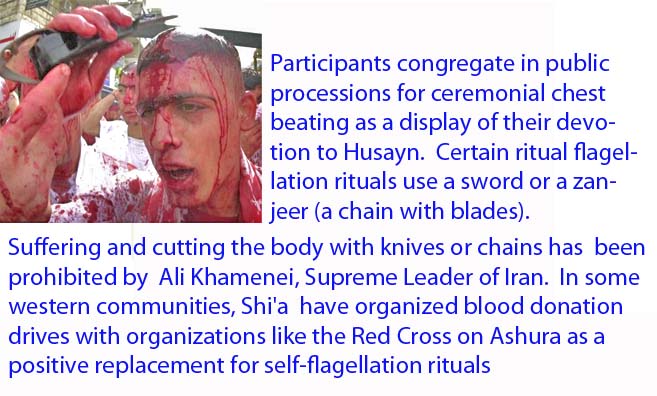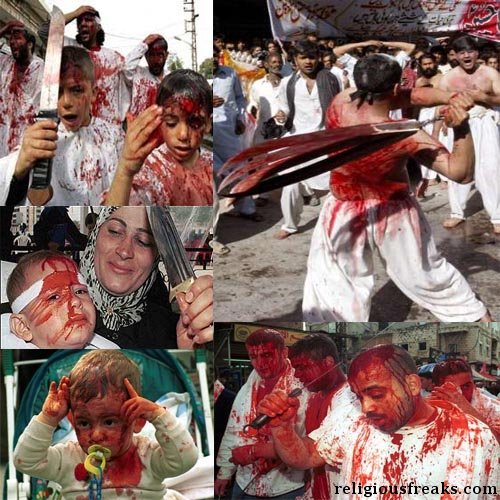
 Muharram, a Muslim month devoted to mourning. Ashura, the tenth of the month, is a day of awe in Shi’a Islam, familiar in the west as scenes of self flagellation.
Muharram, a Muslim month devoted to mourning. Ashura, the tenth of the month, is a day of awe in Shi’a Islam, familiar in the west as scenes of self flagellation.
In Shia Islam the month marks the schism from Sunni, when the Sunni caliph killed the last relative of the Prophet, Ali, and ended his claim to Mohammed’s authority. The massacre occurred in Karbala in today’s Iraq. Today, in Shi’a Iraq, thousands of Muslim men and women will throng around Karbala’s golden domed shrine where Imam Hussein is entombed. They will beat their chests and foreheads in mourning. Some men and boys will beat themselves with chains and cut their scalps to let blood flow.
This year, Muharram began on Tuesday, November 5 and will continue for 29 days until Tuesday, December 3. The Islamic New Year is often observed during the first day of Muharram. Muharram is generally a time of mourning, and many Muslims will fast during Muharram. After Ramadan, Muharram is the most sacred of Muslim months and, as a month of mourning, Muharram is the antithesis of the Christian and Hindu joy filled seasons of Christmas and Diwali.
Karbala
Ashura means the “Tenth” in Arabic and refers to the tenth day of Muharram, the anniversary of the martyrdom of Hussein ibn Ali, the grandson of Muhammad. The last few days up until and including the Day of Ashura are the most important because these were the days in which Hussein and his family and followers (consisting of 72 people, including women, children and elderly people) were killed by the army of Yazid I. Many Sunnis also recognize the importance of the events at Karbala and the martyrdom of Hussein.
The day is sad for two other reasons. It was once a day where Muslims honored their ties to the Jews. Sunni Muslims celebrate Ashura as the day on which the Israelites were freed from the Pharaoh. According to Sunni tradition, Muhammad saw the Jews of Medina fasting on the tenth day of Muharram. He asked, “What is this?” They said, “This is a good day, this is the day when Allah saved the Children of Israel from their enemy and Musa (Moses) fasted on this day.” So he fasted on this day and told the people to fast as well.
The other sad thing is that up until the British Raj, Ashura was celebrated in India by Hindus and Muslims together. Indeed the tenth of Muharram is still a legal holiday in India. From Reza Masoudi Nejad, Practising Fractal Shi’i Identities through Muharram Rituals in Mumbai
As Kidambi (2007) remarks, even Hindus participated in the rituals in Mumbai during the nineteenth century. In fact, observing Ashura day was an inter-community/inter-religion event and the procession on Ashura day was the greatest festival of Mumbai during the nineteenth century, often called the taboot procession. Birdwood (1915) described the procession as the most picturesque event of South Asia.
The Muharram rituals in Mumbai have radically changed since the nineteenth century. The commemorative act as an inter-communal festival came to an end with the riot of 1893. Edwardes, the Commissioner of Police of Bombay at the time, argued that the riot of 1893 broke out as a result of the Hindu Nationalist movement led by Tilak. The movement was initially anti-British, but Tilak widened his movement against Muslims as well (Edwardes 1923, 104–105). Violence between Muslims and Hindus during the month of Muharram became so frequent in the following years that colonial authorities put tight regulations in place regarding the Muharram rituals. The regulation imposed in 1912, during Edwardes’ era, was particularly important in transforming the Ashura commemoration in Mumbai. This regulation banned the issuing of licences for non-Muslims who wished to carry out the procession. In reality, the regulation (1912) indirectly stopped the procession and was part of the process that gradually made the commemoration a solely Shi’i ritual in Mumbai. Although the Ashura commemoration is still known as the Muslims’ (both Shi’a and Sunni) ritual in Indian cities, it is mainly a Shi’i ritual in Mumbai.
Taqabbala Allahu minna wa minkum